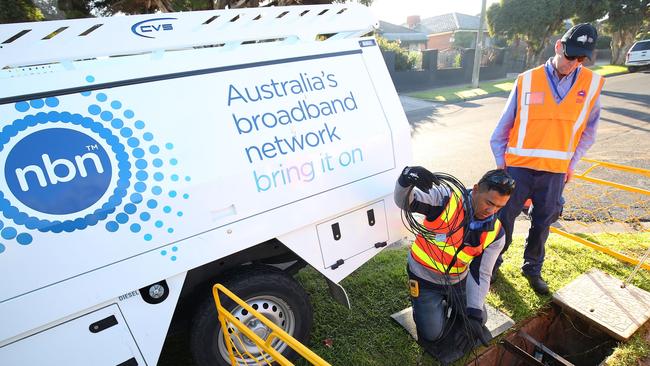Alan Kohler: how to fix the NBN

Last week NBN Co took its first faltering step towards some kind of adulthood. There’s a long way to go.
The decision to delay HFC cable connections so the technology could be fixed was its first assertion of independence from the government, which is on the hook politically for a quick rollout of the network. That’s because speed of rollout was part of the reason given for downgrading it, the real reason being that it had to be different from the ALP’s idea.
Actually, the press release last Monday was a pretty phony piece of spin, and was rightly described as “glitter on a turd” by journalists the next day.
It was headed: “NBN Co takes customer experience improvement program to new levels”, while burying the bad news that HFC connection orders would be paused. But at least CEO Bill Morrow did it, before holding the phone away from his ear when Canberra rang.
The NBN has been horribly politicised from the start and the board and management should have asserted their separation from politics long ago, as other government business enterprises like Australia Post do.
But there’s more to the problem than being smothered by politics. Underlying many of the NBN’s difficulties is that fact that it is a wholesaler with a retail brand and market position.
Wholesaling should be invisible. The customers are retailers, not the public, and if anything goes wrong, the retailer should cop it and then hold the wholesaler to account.
But the NBN has what amounts to a retail brand; consumers all know they are getting the NBN, not a Telstra/Optus/TPG/iPrimus etc broadband service. NBN Co has a call centre and deals directly with end customers, and gets blamed for the problems. The retail service providers are happy to keep their heads down and are getting off lightly.
NBN Co should get rid of its call centre and stop talking to end customers; it should play down the brand, and get rid of the fancy logo.
It’s not just about confused marketing and branding — it leads to confused accountability too, both internally and externally.
No one knows who’s in charge. Is it Telstra and the others? The NBN Co? Or Malcolm Turnbull and Mitch Fifield?
To stop himself being blamed for the problems and get some of the political pressure off the NBN Co, the Prime Minister should announce that, from now on, the NBN Co is an independent statutory body making its own decisions on the rollout timing and funding. He should wash his hands of it — no longer take credit nor wear the blame.
Yes, he made the decision to downgrade the fibre to the premises to fibre to the node, and should wear that, but then he won an election.
Specifically, the 2020 deadline to connect 8.1 million homes and businesses is an arbitrary and absurd political promise. Indeed, the reason for all the spin in this week’s press release was the servile protestations that the deadline would be adhered too, despite the HFC pause.
If NBN Co was a private business it would apologise for any delays and say: we’ll get it right, even it takes longer and delays revenue. It’s not as if everyone is suffering with ADSL and HFC — we’re all watching Netflix perfectly well, although gamers in the bush might be having some problems. Racing to complete the rollout in three years serves nobody, including the government.
As for the company itself, the NBN board needs to restructure the pricing, open the network up to greater retail competition and be much more transparent and honest about the costs and problems (that is, no more spin).
The best thing to do with pricing structure, in my view, would be to remove the choice of speeds entirely, and have one speed only — the fastest possible. For most, I suspect, that would be 50mbs, although by 2020 it really should be 100mbs.
The 12mbs and 25mbs plans should be removed altogether: building a new $50 billion largely fibre broadband network and even allowing 12 and 25mbs speeds on it at all is embarrassing! It makes Australia a laughing stock and makes customers wonder what the fuss, and expense, is about.
The only choice on offer should be the amount of data, as it is for mobile plans, and ideally there would only be two choices of that: 100 gigabytes and unlimited.
Assuming that one speed and two data packs is too blunt and can’t be done, there should be only two speeds to choose from — 50 and 100.
And if the 12/25 speed options need to retained for some reason (so there are very cheap price points to keep politicians happy) then the pricing should be adjusted to herd customers into the higher speeds through incentives — that is, 50 and 100 should be discounted.
More competition would require fewer than the current 121 points of interconnect (POIs) because, at the moment, only four firms are big enough to connect to all of them and have become a gatekeeper cartel.
I’m told that this is impossible, that it’s too late, but I don’t believe it. The ACCC decreed there should be 121 POIs, and the ACCC should undecree it.
As for transparency, the last corporate plan revealed the cost per premise (CPP) of connecting the various NBN technologies: fibre to the premises brownfields, $4,400; FTTP greenfields, $2,100; fibre to the node, $2,300; HFC, $2,300; fibre to the curb, $2,900; fixed wireless, $4,300.
They also, separately, gave the number of each that would be connected when they reached the 8.1 million goal by 2020 and 8.6 million by 2021, which is the most that will ever be connected (they think) — the project planning assumes a maximum of 74 per cent take-up of the NBN, out of the total premises of 11.6 million (that is 8.6m).
So if you multiply the cost per premise of each broadband technology by the number of premises that will get each of those technologies, you get $22.37 billion.
The total cost of the NBN has been put (by NBN Co) at $49 billion — $29.5 billion equity from taxpayers, $19.2 billion in debt.
That’s a $26.63 billion difference between the stated cost of connecting everyone and the total cost of the NBN, which is an awfully big difference.
What’s it for?
* Alan Kohler is Publisher of The Constant Investor




